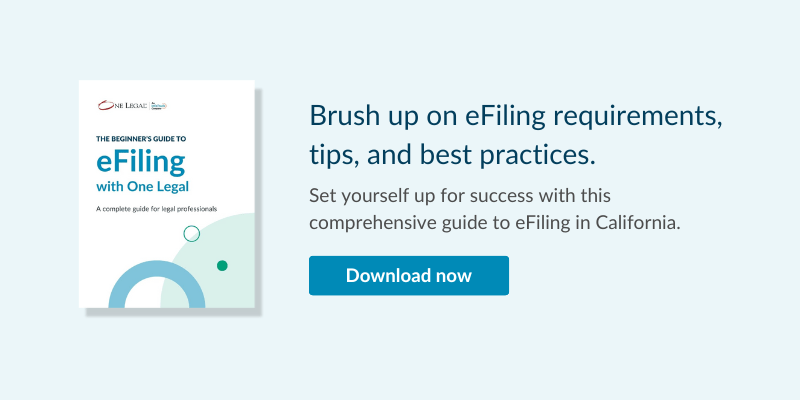When a court first adopts electronic filing, the significant process changes involved naturally generate some confusion. Misunderstandings can persist long after launch about how—and even whether—the new system is working to make the legal process more efficient. This can encourage popular myths that lead to misguided decisions, or even unnecessary work.
Understanding the truth about the process can help clarify how eFiling affects your firm, and improve the way you submit documents to the court.
Let’s demystify these frequent misconceptions about eFiling:
Myth #1 The EFSPs are making me eFile, not the court
If only we had that kind of power! We would definitely use it for good. But only the court has the power to choose how it will permit documents to be filed.
“In states like Indiana and Illinois, the state Supreme Court determined that the entire state would begin eFiling on one common platform, rather than their previous approach of letting every county build its own eFiling system.
These state court systems selected one electronic filing manager (EFM) to handle incoming filings and allowed filers to pick their preferred electronic filing service provider (EFSP) to connect to the EFM. These EFSPs offer their own support and capabilities according to the needs of the firm.
California is, primarily, an open system, in which every county chooses one or more EFMs through which to facilitate eFiling. The courts then allow certified EFSPs to offer premium eFiling services to professional filers.
Myth #2 Conformed copies are sent back instantly
Just like in the paper world, there are sometimes piles (or queues in the eFiling world) that a clerk must go through to get to your filing. So even though your filing arrives almost instantly at the court, it will appear in a queue along with all the other filings, and still must wait for the clerk to review.
Courts prioritize responsive pleadings, filings with statutes, and so on, which means that filed-endorsed copies of less important documents (e.g. Proofs of Service) can take longer to get returned to you. Documents that normally take longer to review, such as defaults, will also take more time to be returned.
While courts haven’t set clear expectations for when they try to return documents, you can typically expect to receive them in 1-2 court days. Again, this varies by the court and by document type.
Myth #3 Judges still print out documents anyway
While we can’t speak for every single judge in every single county, there has been an industry-wide push to print out fewer documents. And the case management system (CMS) within the courthouse is developed to support that goal.
Many judges look at documents on their computers, even reviewing and commenting on the digital pages. And all the details that are required of eFilers further benefit the judges who look at the digital documents. Optical character recognition (OCR) enables them to search and find certain phrases and words; electronically bookmarked exhibits improve navigation within the document.
Whether or not courts require a courtesy copy usually depends on the court’s preference, separate from the eFiling process. Sometimes new eFiling courts initiate a courtesy copy delivery requirement after eFiling goes live, but other times requests scale back as courts become more accustomed to handling digital filings.
As always, check your local rules!
Myth #4 You must use the EFM to eFile with the court—it’s required
When a court requires eFiling, they will clearly lay out which EFSPs have been certified to file with the court. Each of these EFSPs will, in turn, use the established EFM to connect to the court. In many cases, the EFM will also act as an EFSP, adding another option filers can choose.
The key thing to keep in mind is that you are still able to choose which portal you use to eFile, from the court certified options. And EFSPs typically put a lot more effort into intuitive workflows, while also offering additional features like disbursement of fees, simplified billing, and more.
Check your court’s website to see which EFSPs are certified to file in your state or county.
Read more: How to choose an EFSP>>
Myth #5 The EFSP is the one to reject your document
The EFSP delivers your documents straight to the court, securely and quickly. However, the court clerk is the only one with the authority to accept or reject the documents. One Legal will notify you immediately once the rejection has been sent. We will automatically pull any details provided by the clerk about why it was not accepted, including their recommendations to fix it. You’ll see those on your order details page, under “Message from the Clerk.”
Filers can use optional add-ons, like One Legal’s Double Check service, to request that One Legal first review the document for common issues that might lead to rejection. We can’t reject or accept documents for you, but we can ensure that your documents are ready to go before they reach the clerks.
Read more: Top rejection reasons in 2017/2018 [report]>>
It’s easy to see why eFiling can get confusing. When the storied past of the legal industry merges with the burgeoning era of technology, there is bound to be some misunderstanding. Review your local court rules for accuracy and take advantage of resources provided by One Legal and other sources.
This is Part 1 of our Top 10 myths about eFiling. Check back soon for Part 2 to learn more about frequent misconceptions about eFiling, and how to better understand and address them.
Part 2 of Top 10 myths about eFiling is available now!
What are some rumors you’ve heard about eFiling? Share in the comments!








